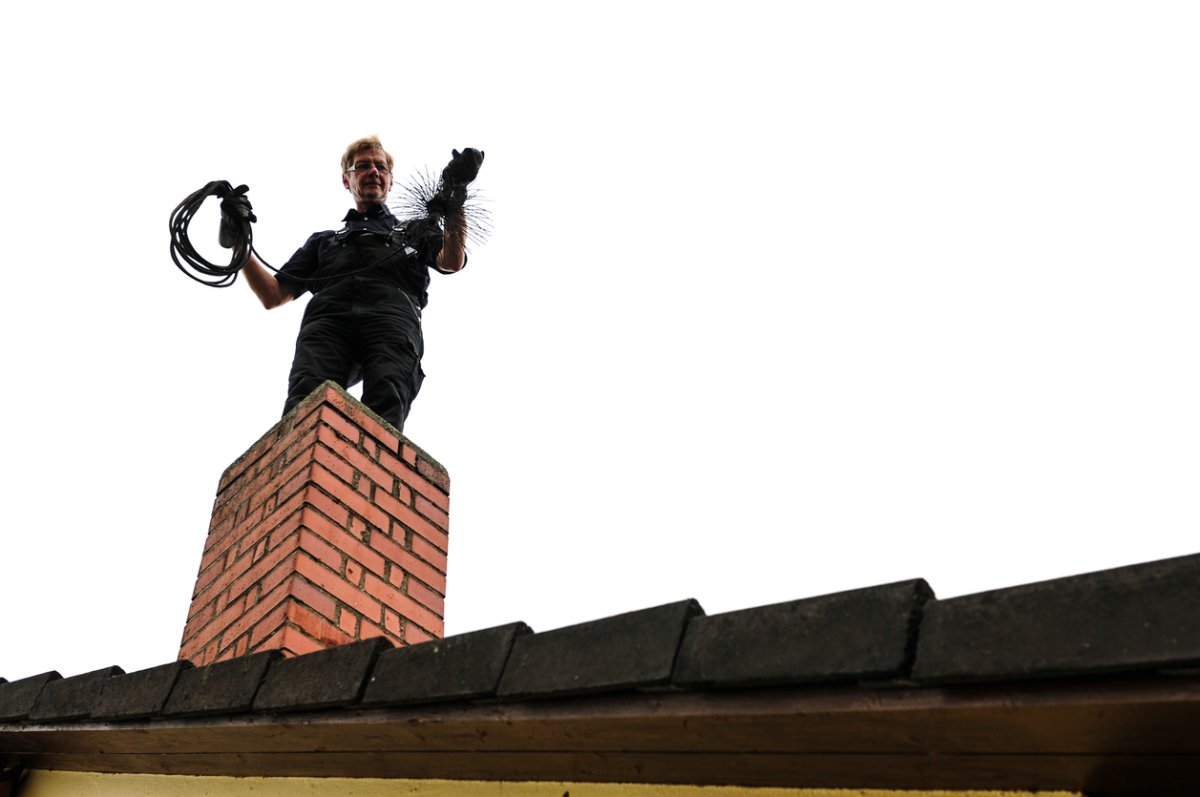

We may earn revenue from the products available on this page and participate in affiliate programs. Learn More ›
Some folks love the romance of a wood-burning fire. Others may prefer the all-night warmth of a wood stove. But almost everyone can agree they’d prefer their fires to stay safely in the firebox of their chosen appliance and not roaring up their chimneys, burning at temperatures in excess of 2,000 degrees Fahrenheit.
A clean flue is critical for avoiding a catastrophic chimney fire. While the task might seem intimidating—what if you mess up somehow?—cleaning a chimney is surprisingly easy. Ahead, learn how to clean a chimney, including a list of tools you need to get the job done.
Why is it important to clean your chimney?
Cleaning a chimney is incredibly important, because a chimney’s function is to allow dangerous chemicals and gasses to escape from the home. During the combustion process, a fireplace or wood stove produces smoke. The smoke is full of gasses and a chemical compound called creosote. Creosote is a sticky, tar-like substance, and it likes to grab onto every surface it can as it travels up the chimney.
Some creosote buildup is normal on wood stove doors and even the sides of the chimney, and can be removed with a creosote cleaner. Routine cleaning will help minimize the danger creosote poses in the chimney, though. Considerable creosote buildup in a chimney is almost like rocket fuel, waiting for ignition. Creosote is incredibly flammable and will burn at temperatures in excess of 2,000 degrees Fahrenheit. Those temperatures can crack chimney flues and cause the fire to spread to the rest of the home.
In fact, some estimates hold that dangerous accumulations of creosote contribute to about 25 percent of all house fires. Folks who have experienced chimney fires often describe the noise coming from the chimney as sounding like a freight train going by. It’s terrifying stuff.
Cleaning your chimney also gives you an opportunity to ensure there are no other obstructions. Birds, bees, squirrels, branches, and leaves can all clog a chimney and prevent the necessary updraft to remove the smoke and chemicals caused in the combustion process. (Unless you have the appetite for smoked squirrel, it’s best to chase them from the chimney before the first fire of the season, anyway.)
Finally, a clean chimney is an efficient chimney. With the proper amount of airflow coursing through the fireplace or wood stove, the wood can burn hotter (albeit faster), and produce more thermal energy. If a chimney is choked by obstructions, it won’t pull enough fresh air into the firebox, preventing optimal combustion.
How often should you clean your chimney?
Chimney cleaning should be part of your regular house maintenance program. The best rule of thumb? Clean it right before the heating season starts, so once a year. This ensures that there are no obstructions in the chimney flue when the burning season starts, and the chances of wildlife setting up shop for the rest of the season are pretty minimal.
It’s also a good idea to inspect a chimney once during the burning season, if conditions allow. This is particularly important if the wood you’re burning isn’t particularly well-seasoned (as is often the case with late-season wood deliveries). Just be sure to give the chimney plenty of time to cool down (at least a day) before inspecting, and ensure that there aren’t any embers in the wood stove that can reignite with the introduction of oxygen.
If you’re not confident with the condition of your chimney during the season, it may be best to hire a chimney specialist to perform an inspection.
How to Reduce Creosote Buildup
You can reduce the amount of creosote that builds up in your chimney by just changing a few of your wood-burning habits.
- Use dry, well-seasoned hardwood. Moisture in wood prevents efficient combustion and produces steam, which means lower combustion temperatures. This will prevent creosote particles from escaping out of the chimney, leading them to collect on the sides of the flue instead.
- Understand that burning wood slowly by choking the airflow into the wood stove or wood burning insert can lead to creosote buildup. Again, colder combustion temperatures produce slower-moving smoke, which can lead to creosote buildup.
Here’s a tip for folks who like to set their wood stoves up to burn all night: When you wake up, burn a hot fire right away. This is a trick that old-school wood burners used to prevent creosote buildup from the night before. Feed the stove and allow plenty of airflow (500 to 600 degrees Fahrenheit measured by a flue pipe thermometer) for 20 to 30 minutes, and then maintain a flue temperature of around 300 to 400 degrees for the rest of the day.
Tools & Materials
Bobvila.com may earn a commission from purchases made through these links.
Project Overview
Working Time: 2 hours
Total Time: 3 hours
Skill Level: Beginner
Estimated Cost: $50 to $100
Before You Begin

The best way to clean a chimney is to approach it from the roof, but climbing onto a roof poses its own challenges. Make sure that the ladder is secure and that you have good footing before stepping onto the roof. Once on the roof, beware the shingles can be slippery when wet, or when they’re starting to delaminate. Always take extreme care when scaling ladders and roofs, and have a spotter on the ground ready to help you should you need it.
How to Clean a Chimney
While creosote might be scary, the process of learning how to clean your chimney isn’t all that hard. Just follow these steps to ensure your chimney is clean and burning efficiently this year.
Step 1: Clean and seal your fireplace or wood stove.
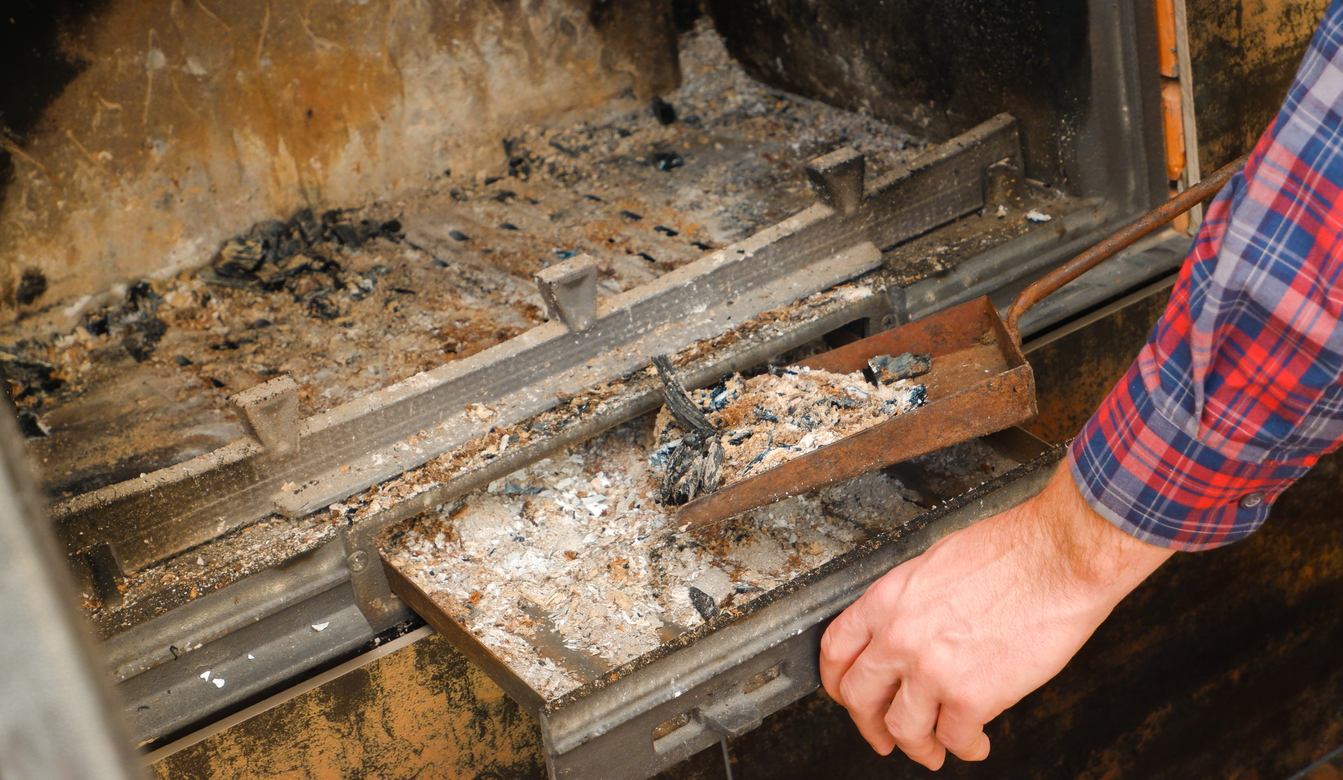
Cleaning a chimney is much easier when starting with a clean wood stove or fireplace. Remove any ash and coals (make sure there are no live coals before removing!), as well as any log stands or other hardware that might be in the way. Brush debris out of the corners and use the shop vac to remove any stray dust.
Also, there’s no way to avoid dust when cleaning a chimney, but you can contain it. Use thick plastic sheeting and seal the fireplace. Tape it to the brick or fireplace surround to ensure that it’s fairly airtight, and that floating ash won’t be able to escape into the home. Throw drop cloths down on the mantle as well.
To help minimize the mess even further, cut a small hole in the plastic, insert the nozzle of the shop vac, and tape the nozzle to the plastic to seal the hole. This is an excellent opportunity to use a remote-controlled shop vac like this model from DeWalt (you can thank us later).
For wood stoves, simply keep the door shut for the first part of this process.
RELATED: How to Clean a Fireplace
Step 2: Climb onto the roof.
Once the fireplace is sealed from the rest of the house, grab a multi-screwdriver, a pair of pliers, and a flashlight and place them in your pocket or tool belt. If you have a remote control for the shop vac, place it on your wrist and ensure it works. Don your work gloves, safety glasses, and dust mask, as well. It’s time to climb the roof, and you’ll need these tools once you get up there.
Set up the ladder so that there are at least three rungs above the edge of the roof. These rungs provide a handhold as well as some counterweight above the roof to keep the ladder in place. Have a helper hand you the chimney brushes and rods.
As always, be careful when getting on and off the roof and ladder. If you’re not comfortable with ladders, roofs, or heights in general, it’s best to call a professional. Many of the most dangerous DIY projects are so dangerous because of heights, and it’s best not to take the risk.
Pro tip: For steep roofs, work on the peak side of the chimney. This will give you something to steady yourself and prevent falling.
Step 3: Remove the chimney cap.
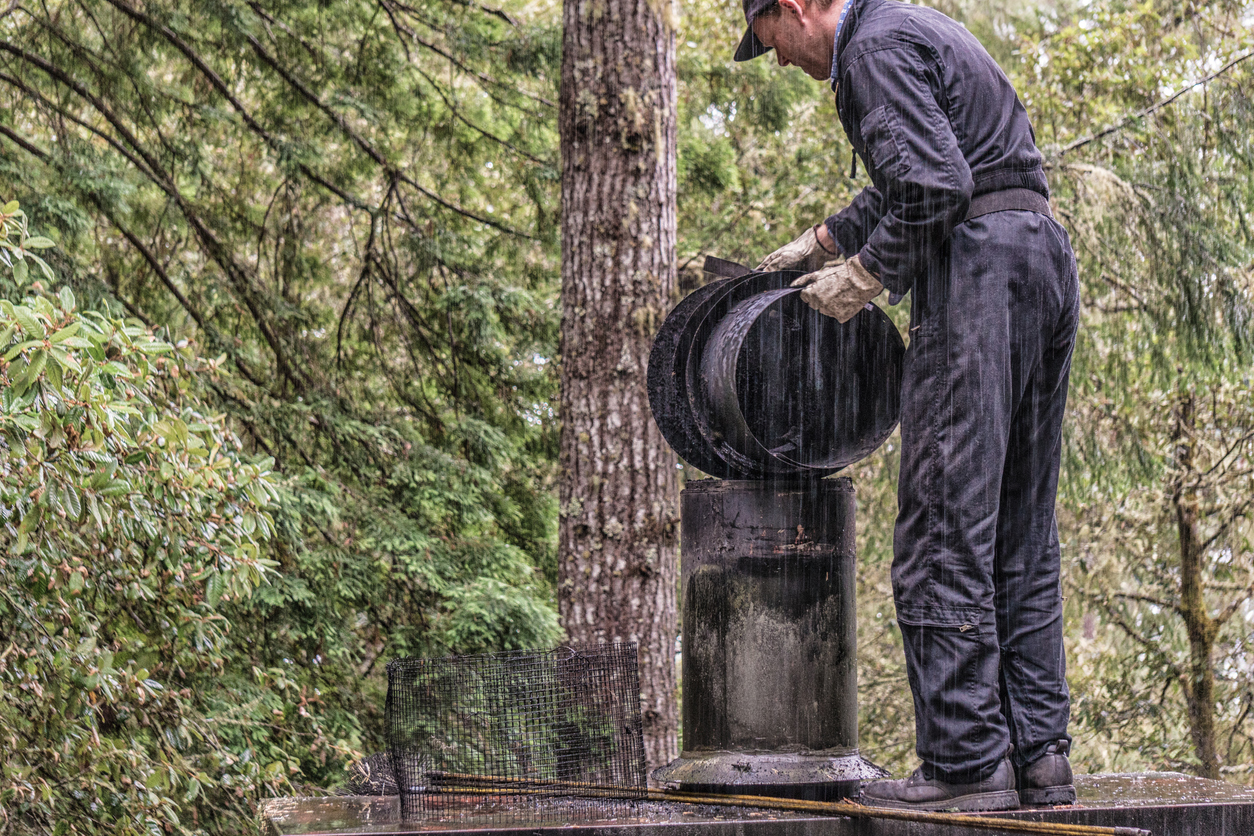
Most chimneys have a cap on top that attaches to the flue. They’re held one with screws or bolts, and they’re relatively easy to remove. A word of caution, however: Be sure to peek into the chimney cap first to ensure there aren’t any surprises inside (namely, bees or wasps).
Once removed, place the chimney cap safely aside to prevent stepping on it and slipping.
Step 4: Inspect the chimney.
Grab your flashlight and take a look down the chimney flue. If it’s a little dusty, turn on the remote-controlled shop vac to pull the dust downward and away from your face.
While looking down the chimney, look for signs of creosote buildup. Small bumps and deposits are totally normal (they may even be shiny), but any running creosote that looks like a liquid is a bad sign, and you may need to call a professional for chimney cleaning if this DIY cleaning doesn’t work.
Now is also the time to look for any obstructions or damage that might exist. If you see visible cracking in the flue, wildlife nests or carcasses, or large items in the chimney, you’ll probably need a professional to repair or remove these items and check the flue for safety.
RELATED: Everything to Know About Chimney Inspection Cost
STEP 5: Brush the chimney.
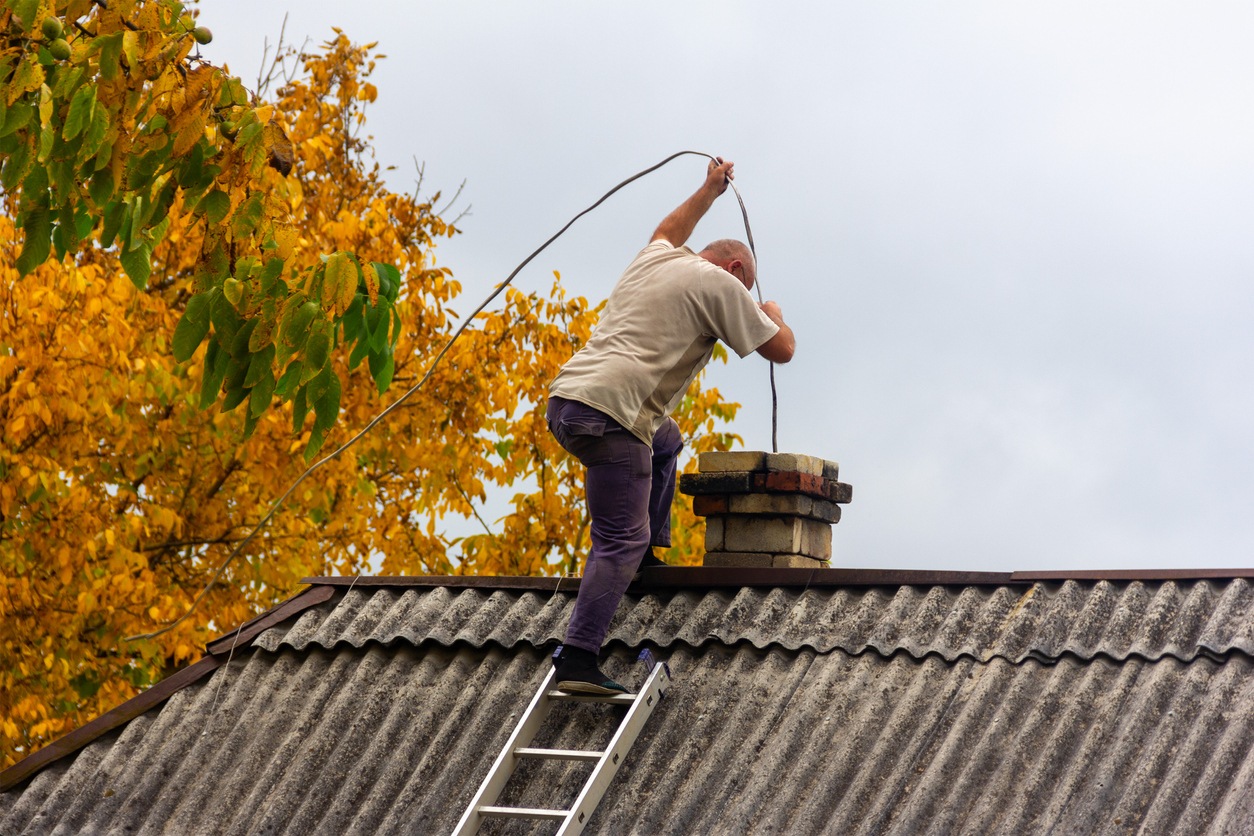
Once you’re confident this is still a DIY job, it’s time to start brushing. Start by fitting the largest chimney brush that will fit down the flue on the end of a chimney brush rod (they usually screw on, but there are other types as well). Carefully push the chimney brush into the flue and brush up and down several times. Make sure the shop vac is running as this will create a lot of dust.
Once you’ve brushed back and forth, add another rod to the end of the rod attached to the brush and continue brushing lower. The rod will likely flex more, and the friction will make the motion difficult, but continue until you’ve brushed up and down multiple times.
Continue adding rods until you’ve reached the damper. If you’ve reached a smaller section of stovepipe, remove the brush, fit it with a smaller chimney brush, and continue the process until the smaller pipe is clean.
Note: At first, each pass will be difficult because the creosote is preventing easy passage. However, after the flue is clean, it will be much easier to push the brush through, at which point it may be time to add another rod.
Step 6: Inspect your work.
Once you’ve brushed all of the chimney flue that you can reach, slowly remove the brush from the chimney (slow speed prevents the bristles from flicking debris at you while removing it). Allow the dust to settle for a few minutes while the shop vac is still running.
Once you’re able to see into the flue, inspect it with the flashlight to ensure that all of the build-up has been removed and that the chimney flue is clean. Once clean, carefully remove the rods and brush and hand them down to your helper.
RELATED: Solved! Why Your Fireplace Might Be Smoking Up the House
Step 7: Replace the chimney cap and carefully climb down.
Inspect the chimney cap to ensure that it’s in good shape and that you didn’t damage it during the cleaning process. Place it back on top of the chimney and secure it in place with the screwdriver or pliers and the original hardware. Lift up to ensure that it’s secure.
Once you’re satisfied that the cap is secure, carefully walk down the roof toward the ladder and climb down.
Step 8: Clean the damper and firebox.
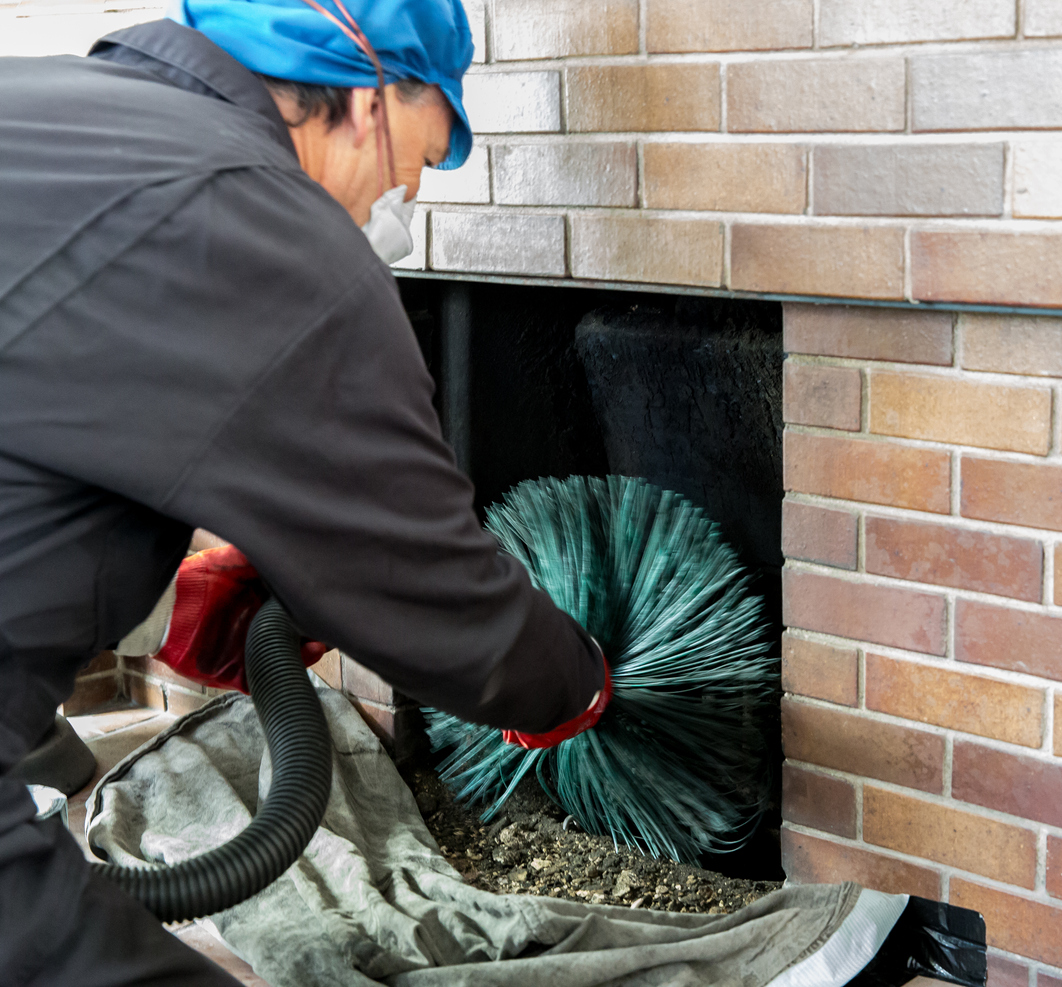
The process of cleaning the flue will drop piles of flaky, chunky creosote and other particles onto the damper and into the firebox. Ensure that the dust has settled by giving the fireplace or wood stove 30 to 60 minutes to settle. After that point, remove the shop vac’s hose from the plastic and carefully remove the plastic from around the firebox.
Use the flashlight to peer inside the chimney and locate the piles of creosote. Use the shop vac to suck up any loose piles. Use a handled brush to reach up around the damper and knock down any debris. If the damper is dirty, use a wire brush to clean it (you don’t need to remove it).
The process is different for wood stoves. Disconnect the wood stove from the chimney by removing the sections of black stove pipe (you may need to slide the wood stove slightly to do this, so enlist your helper again). With the pipe removed, you should be able to see into the top of the wood stove and locate the piles of creosote. Vacuum these out and replace the stove and stove pipe.
Step 9: Clean up and dispose of the creosote.
Carefully clean up the plastic, drop cloths, and other items. Avoid shaking them if possible, as they’re covered in ash and creosote and will kick up a bit of dust. Vacuum up any dust films and then carefully empty the shop vac into a trash bag.
There are quite a few laws that determine how to dispose of creosote. Generally speaking, the creosote from a fireplace chimney can be bagged and thrown in normal trash, but it’s important to check with the local town hall or waste facility to ensure that this is okay.
When should you call a chimney sweeping professional?
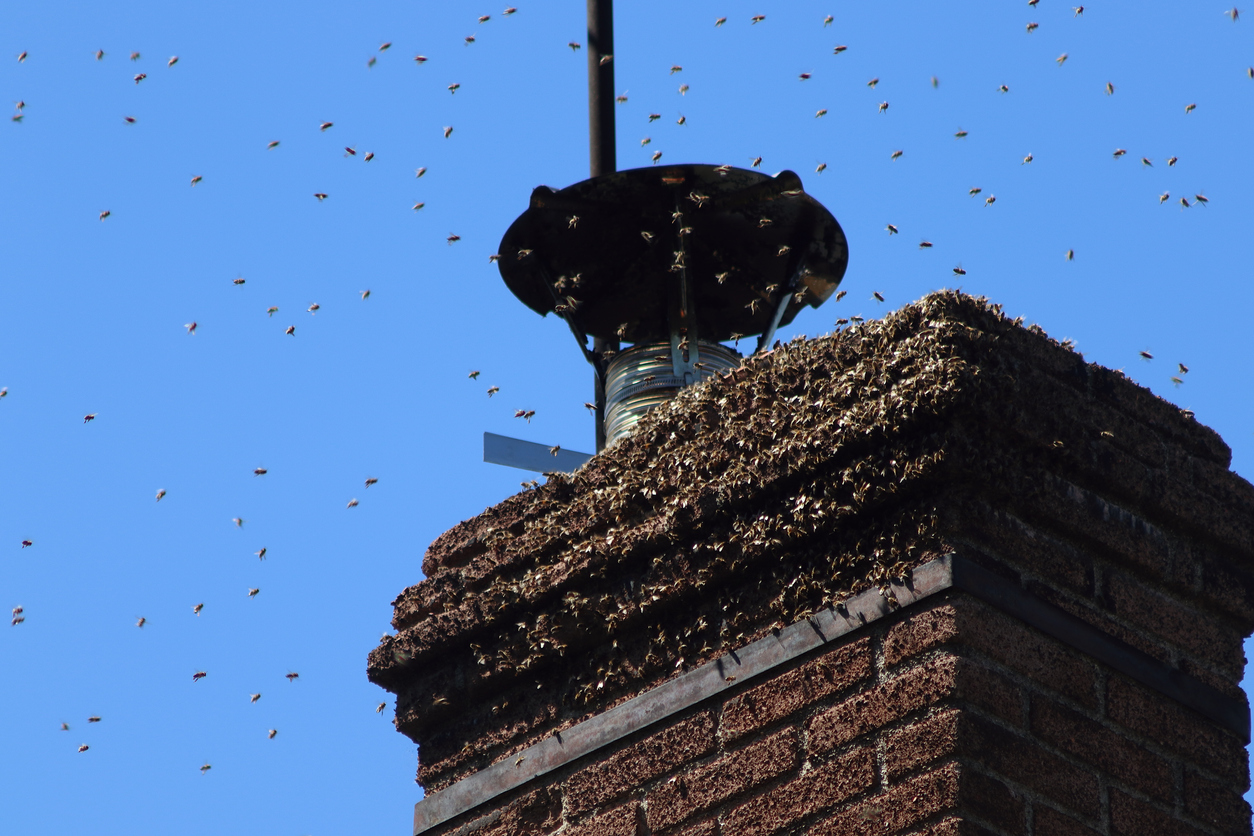
The act of chimney cleaning isn’t hard, but there are some instances when it’s better to call a chimney sweeping professional. For example, if there is a blockage in the chimney caused by wildlife or bees and wasps, calling a local pro makes more sense than getting bitten or stung.
Also, if you’re not comfortable on a ladder, you might consider letting someone else clean your chimney. While you can do it from inside the home, it’s much messier, so call a professional.
Finally, if your chimney is older, hasn’t been used in a few years, or is showing signs of visible wear, do not clean and use your chimney—the risk is not worth the cost of hiring a professional. Call a professional who can come in and verify that your chimney is safe. If not, they may suggest installing a new liner to protect the home from fires. That’s not something the average DIYer can confidently handle.
